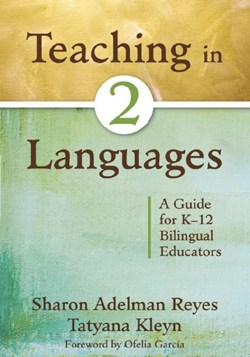Bringing Back Bilingualism
A new book by a TC alumna argues for the strength of a true dual-language approach
A new book by a TC alumna argues for the strength of a true dual-language approach
TC alumna Tatyana Kleyn was six when her family left the Soviet Union and came to the United States. During her first few years here, she felt embarrassed by her heritage and by the Russian language, in particular. It wasn’t until her mother visited her sixth grade class to discuss immigration and the anti-Semitism the family had left behind that Kleyn’s embarrassment changed to pride. She began to embrace her own bilingualism, as well as to introduce herself as “Tatyana,” her given name, instead of as the more American-sounding “Tanya.”
Today, Kleyn, Assistant Professor of Bilingual Education and TESOL at The City College of New York, is on a mission: to bring back the “B-word”—bilingualism, which she believes has fallen victim to U.S. education policies that deny non-native English speakers access to their own first languages and cultural strengths.
“Bilingual education is often marginalized and bilingual teachers often find themselves on the periphery, lacking resources available to their mainstream counterparts,” Kleyn said in September when she returned to TC to discuss Teaching In Two Languages: A Guide for K–12 Bilingual Educators (Corwin Press, 2010), which she co-authored with Sharon Adelman Reyes, Assistant Professor of Education at Gonzaga University.
The book’s chapters pose key practical questions, including “How do I use two languages in the bilingual classroom?”, which the authors believe is the most pressing issue facing bilingual teachers today. Rather than capitalizing on the interplay between two languages, Kleyn and Reyes write, most bilingual programs stem from “a monolingual approach, with the goal being either English monolingualism or bilingualism that is really double monolingualism.”
With that in mind, the book seeks to provide bilingual teachers with specific strategies for dual language instruction. The authors begin by casting a wide net, defining “bilingual education” broadly to include programs variously headed one- and two-way bilingual immersion, transitional bilingual, ESL, foreign-language, after-school and weekend, private school, and even religious.
They take a similarly broad view of “emergent bilingual students,” including both U.S.-born and immigrant speakers of a language other than English, U.S.-born and immigrant bilingual and multilingual speakers, and monolingual speakers of English varieties.
Right now, Kleyn seemed to suggest, there isn’t much of a national conversation uniting the approaches to all these different groups. At TC, when an audience member asked, “Who is responsible for promoting the importance of the different types of bilingual education?” Kleyn replied, “Everyone. The Department of Education, schools, and teachers.” Most of all, she said, “there needs to be a conversation about informing parents about how their kids are being educated.” Maybe then, there would be more classroom visits that left children feeling proud of speaking two languages.
Published Tuesday, Dec. 21, 2010
